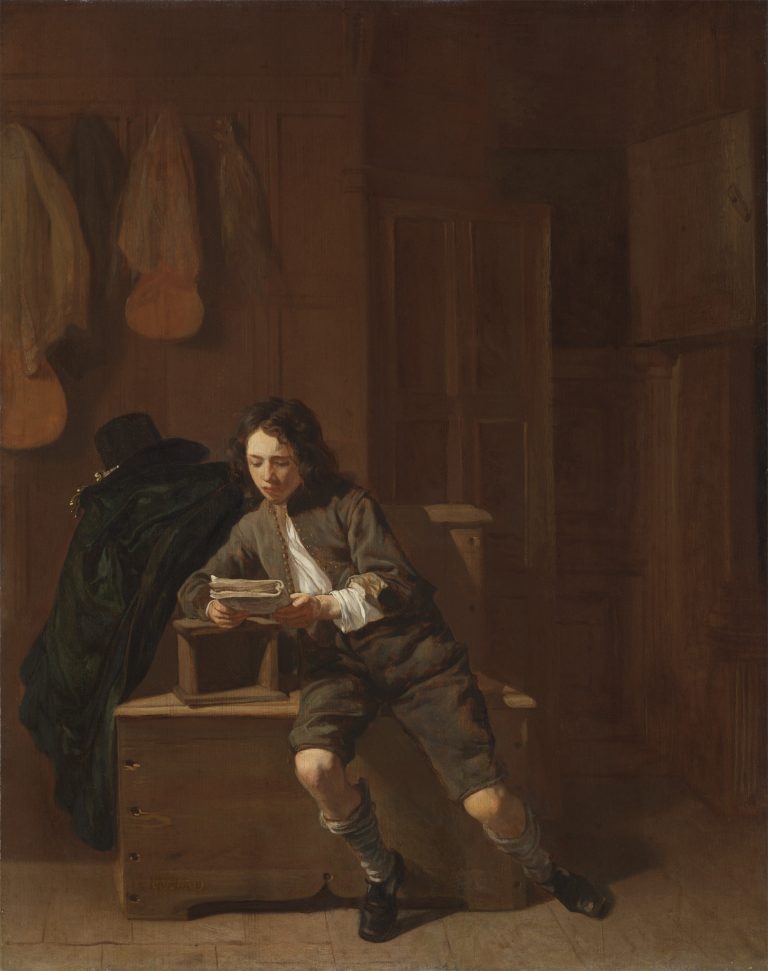When Jacob van Loo turned his brush to the human figure, his subject was usually the female nude.1 He was known for orienting these nudes on a vertical canvas and enveloping them in soft light that allowed shadows to dance across the exquisitely rendered fabrics barely covering their luminous skin.2 He nuanced their gestures and facial expressions so much that one could easily imagine their thoughts and personalities. With a similar sensitivity to his subject’s psychological character, Van Loo has here captured the intense concentration of a young man reading.
The youth, who sits on a chest or bench while leaning on a foot warmer (fig 1), grips a thin book or manuscript, the spine of which he has fully inverted, as he carefully studies its text. The room is entirely brown, with its floor-to-ceiling wood panels, doors, and floor, making it difficult to interpret either spatially or functionally. It may be a transitional space between the inside and outside, such as a mudroom or entrance hall to a home. Hanging on the wall are two musical instruments, probably a violin and a viola, that are partially covered by clothes, suggesting that the young man may be waiting for a music lesson, and the text he is studying is a musical score.
Music was a passion of the privileged elite, and the young man’s fashionable clothing, indeed, identifies him as part of the upper class.3 Typically, however, artists focused on musical ensembles already engaged in the act, rather than on a musician preparing for a lesson. Such scenes, including one depicted by Van Loo in the mid-1660s (fig 2), offered the opportunity to show amorous interactions between men and women given that the playing of music metaphorically referred to the unison of lovers’ hearts. Although Van Loo’s decision to picture the boy studying is, thus, unusual, it was likely inspired by two of his previous works related to the composition: Man Holding a Woman on His Knees, which is signed and dated 1650, and Scholar in His Study from the early 1650s (fig 3).4 In the former work, a man and woman carouse in a wood-paneled room highly reminiscent of the space in Young Man Reading. In the latter work, a young scholar in a nearly identical pose toLeiden Collection young man sits in a room cluttered with papers, books, scientific instruments, and other curiosities, keeping with traditional representations of scholars and academics.
Despite the similarity of these works—especially the figure of the youth, whom Van Loo appears to have plucked from one composition for the other—each of the three scenes has a very different energy. The amorousness of the couple in Man Holding a Woman on His Knees and disorder of the scholar’s room in Scholar in His Study endow the paintings with a dynamic energy that is entirely unlike the sense of quietude and contemplation that pervades Young Man Reading. That Van Loo executed the Leiden Collection work after the other paintings is confirmed by technical analysis. Infrared reflectography shows that the young man’s proper right foot was originally smaller and located slightly higher than that of the youth in Scholar in His Study. Van Loo, perhaps utilizing a now-lost preliminary drawing, revised the boy’s position when making this work (see technical notes).5
The tranquil isolation of the figure in Young Man Reading is also unusual in its focus on a young man reading by himself. Occasionally in Dutch art one finds depictions of young boys reading books in the presence of a mentor or instructor (fig 4), but these are few in number.6 Generally, individuals reading books (as opposed to letters) are elderly women,7 scholars in their studies,8 or saints, such as Paul or Jerome.9 Van Loo’s painting thus occupies a special place in genre imagery of reading. Showing neither scholar, nor saint, nor student, it is a representation of the joy and pleasure of reading, and its ability to captivate and engross the mind.
